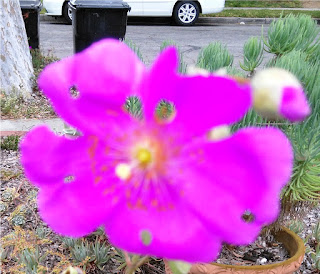
Two years ago I wrote about "white gardenias . . . mingling with cerise calandrinias" as bedfellows in our front garden. Above at left is a photo from that post. Below, at right, is a photo I took last Saturday, June 6:
The most obvious difference here is that the second gardenia hasn't opened yet, but let's look more closely at the two calandrinias. A honey bee graces the upper one, camouflaging herself cleverly against stamens and stigma, while a perfectly round hole in the lower one (look at 10:30) suggests that a less beneficent insect has come and gone.
It took me several days to figure out what had happened.
Early last week I was sitting at our little bistro table, contentedly watching a calandrinia blossom bob up and down on its long stem. I noticed what appeared to be a white spot on one of the petals. Closer inspection revealed that the spot was actually a hole framing a white object in the distance, possibly a white car parked on the street. On Friday (I can identify the day because there are trash bins at the curb), I spotted the ultimate calandrinia perforation: six holes spaced evenly among the flower's five petals. Each of the larger two was about 1/8" in diameter, while the smaller four averaged about 1/16" in diameter:
On Saturday, the day after sighting the holey calandrinia shown above, I decided to survey the entire calandrinia population: possibly eight flowers open at that time, each one on a long, separate stalk. That was when I found and photographed the one-holed blossom shown at the top of this page. None of the others seemed to be afflicted. The perforated calandrinia shown above had folded up and been replaced by the bud that's peering over its shoulder in the picture. But wait! There was something strange about that new flower. A little yellow-green grasshopper was perched on it. I tried to take a picture, but the insect was too fast for me. I was happy to have scared him away from a flower that was still unscathed, but strongly suspected that he would return as soon as my back was turned.
My next stop, of course, was the Internet, where I Googled 'grasshopper damage.' I learned that not all grasshopper damage consists of small holes, and that not all small holes in leaves and flowers are made by grasshoppers. Industry-standard grasshopper eradication, moreover, requires more than one season, as an expensive fungus must be made available when eggs are hatching in early spring. The pesticides favored by organic gardeners -- bacillus thuringiensis (b.t.) and hot pepper in a soap or wax base -- do not claim to deter grasshoppers. Maybe some of the damage to the kale in my little vegetable garden has been caused by grasshoppers rather than the cabbage worms I've been trying to fight with alternating applications of pepper spray and b.t. We live and learn.
I also learned that the best biological control for grasshoppers and many other insects, especially in a small-scale operation, is a little flock of chickens. My friend Michelle has four or five 'rescue' hens who spend much of their time hunting down and devouring insects which are then converted into delicious eggs. I don't remember whether Michelle has any calandrinias, but if she does I'll bet they aren't as holey as mine.



6 comments:
Yes! Oh how wonderful would it be to have fresh eggs from your own backyard. What would the noise situation be like with hens? I wonder...
Raquel,
Roosters are the noisy ones! Michelle's hens keep up a pleasant soft clucking 'song,' never going above mezzo-piano.
Now I know what probably is eating out holes in my flowers and other decorative plants. I occasionally come upon a grasshopper but they are too fast for my destructive blow.
My mother would actually catch grasshoppers with her bare hands, decapitate them with her thumb nail, and give them to the cat. They still had enough nerve activity to make an interesting toy.
Frances's mother sounds so bold and at the same time, so practical. As Frances says, the chickens do a great job of keeping the unwanted insects under control, with one exception....sadly they can't do anything about the insects that favor veggies, because the veggies need to be fenced off from the chickens. The calendrinia, they have no holes. Regarding chickens and noise, sometimes the girls get a bit rowdy in the early morning, so if you and your neighbors aren't early risers, this could present a problem. After 5 years of chicken keeping in this urban neighborhood, I only hear comments like "I heard your chickens" or "you have chickens in there". when I ask if they have been disturbed by the noise, they reply that they like the sounds. The chickens have some regular visitors, usually preschoolers and their parents. The eggs, needless to say, are delicious. (Michelle)
My mother (1915-2013) was bold indeed! One time she held a rattlesnake at bay with a hoe while a 'cowboy' shot it with a rifle. Nerves of steel. One of these days I'll blog about her.
Recently I heard pleasant chicken sounds from the house behind our next-door neighbor. So surprised and pleased. The urban chicken phenomenon is getting to be a trend.
Post a Comment